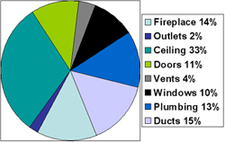Q: Jason – I see in some places on the chimney balloon website and in literature you state that a Chimney Balloon can save a homeowner $200 in home heat. How do you get that figure? – JP
A: Dear JP, I’m glad you ask this. A person should always challenge marketing claims of any product. Lets take a look at what the Department of Energy, the Energy Information Administration, and some independent studies say…
Open or Missing Fireplace Dampers:
A European research study titled “Ventilation perturbations due to an open fireplace in a house” – by P. Dalicieux and C. Nicolas concluded that a missing or left open fireplace damper can result in a home to have a 30% increase in heating costs. The US Energy Information Administration said that in 2005-2006 the average US family spent $1044 on home heating bills. This information is on their 2005-2006 report. So 30% of $1044 is $313. Keep in mind this is 2005-2006 information and energy cost trends have home heating cost increasing 25%-30% each year since then. As you can see, $313 is more than our more conservative statement about $200 in savings using a Chimney Balloon. But, lets look at another study…Fireplace Dampers That are Functional or Damaged:
The Department of Energy (DOE) states that 14% of a homes heat loss is lost through the fireplace even when there is a damper in the fireplace. They also say the average family in 2005 spends $1600 per year on utility bills. Personally, I think this figure is low. I live in a tight 1100 sq ft ranch (with new power vent furnace and water heater) and I know I spent more than $2000 on utilities in 2007, but I suppose the DOE is figuring in the North and South US climates together.So if we spend the $1044 per year on home heat that the (The US Energy Information Administration says we spend) and 14% goes up the fireplace flue, then the person is loosing $146 in home heat per year even if you have a functional damper.
So with these two studies we take the average between the two to be $230 in home heat. That is where we get our $200 in heat savings. I hope you can pardon us for rounding down on the final figure. – Jason
